[PRE-ANN] [FLUXEL] OpenDrop is an open source microfluidics platform tied to a crypto asset and a DCO
“ We become what we behold. We shape our tools and then our tools shape us”
--Marshall McLuhan, attributed by Father John Culkin
Abstract
OpenDrop1 is an electrowetting on dielectric-based (EWOD)2 , open source3, micro-electro-fludics hardware device, able to control droplets of fluids such that they mix, split or move4 from one location of the operating array to another. In the development of OpenDrop (OD) we are deploying an innovative governance and operations management system which is meant to be adaptive, dynamic and anti-fragile5. We have layed the foundations for our governance in the principles of commons-based peer production6,7, and liquid management8 allowing anyone to contribute, and for this contribution to be accounted by leveraging an incentive system based on a DLT* system (on an existing and functional blockchain 2.0 infrastructure TBD). Moreover, with the implementation of open source references (materials & methods, hardware and software), OD can further be developed by the growing worldwide community of contributors in order to expand its applications and to fully integrate the procedures needed during molecular biology experiments (e.g. sensors, actuators, electric and optic technology, temperature and magnetic bars).
* DLTs = Distributed Ledger Technologies
Intro
In biology laboratories hours of manual work are considered a compulsory part of the experiment. In the past decade, a big effort has been done to develop machines (e.g. pipetting robots) that would automate some of the recurrent tasks in a molecular biology lab (pipetting, mixing, splitting, handling, labeling etc.)9.
Despite the effort, these machines are: large sized, task-specific, difficult to use, and most importantly, extremely expensive. With OD, we propose an advancement from automated biology to digital biology.
In our vision, digital biolab should be:
- fully integrated, running all the tasks on the same machine;
- easy to use, with an intuitive user experience for software and hardware control;
- general-purpose, allowing easy reconfiguration for design of new experiments;
- low-cost and accessible, offering affordable (around € 300-2000) and do-it-yourself assembly kits.
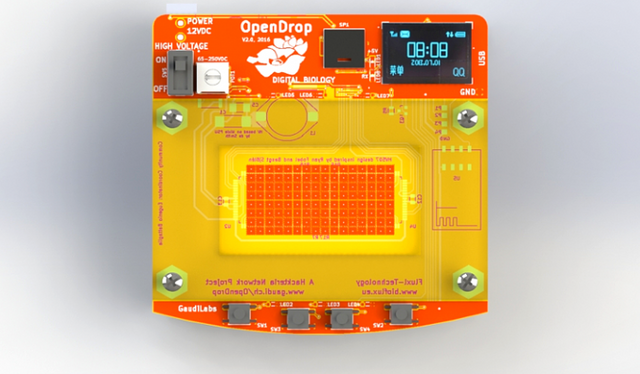
Lab-on-a-chip devices reduce by many folds the quantity of samples (scarce and expensive to produce) and reagents (expensive) in order to perform biochemical reactions. Moreover, such devices reduce the reaction time by increasing the surface-to-volume ratio, and they allow for exquisite controllability of reaction conditions providing high end stimulation and sensing (e.g. electrical or optical) mechanisms.
Once slow and difficult to setup even for an average end consumer (e.g biomolecular reseracher), now the industry is moving towards general purpose, high speed, and easy multiplexing devices.
Digital microfluidics (DMF) is now a huge and mature trend in the field of nanobiotechnology, and after more than 20 years of development it is now showing to perfom better than other microfluidics systems, making it the best candidate for mass production for a wide range of commercial applications. It is suitable for a large plethora of biological assays, from high precision sample preparations, to lab-on-a-chip applications as well as point-of-care applications.
Ultimately, OD modularity makes it suitable for coupled setups with continuos microfludics devices such as together they can perform programmable high throughput sample processing.
Hardware specifications
The current prototype of OD deploys a double layer Printed Circuit Board (PCB) designed as a modular (multiple of 8×8 electrode array) originally designed as a shield for the highly-standardized Arduino AVR-based microcontroller platform10.
The current version it's cased with an Arduino Micro. The core hardware technology of OD is based on a gold coated array of electrodes, covered by a disposable general-purpose use cartridge which is made of a dielectric layer sheet coated for superamphiphobicity and a inkjet printed conductive paper.
The control of the elctrowetting capabilities of the device is provided by two High Voltage Driver Chip HV507 on the back of the PCB. OD integrates the required voltage step-up circuit to generate the high voltage needed to modulate the electrowetting properties of the cartridge setup.
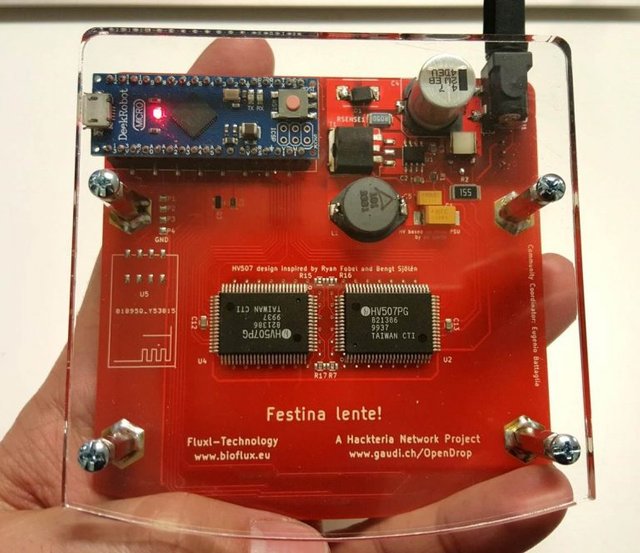
The hardware of which OD platform is consisted, is digitally controlled by an intuitive software interface that allows to standardize and share lab protocols among users.
OD aims at contributing to the rising field of Digital Biology, by allowing technical communities to share highly standardized and replicable protocols at a marginal cost, while also allowing non-technical communities (makers, artists, young students, biohackers) to explore rapid prototying applications in the field of molecular and cell biology.
OpenDrop v2 specs:
– 2x High Voltage Driver Chip HV507
– 16×8 electrodes array, 2.75mm2 in size
– Arduino Micro
– 4 buttons
– tiny OLED Display
– WIFI module
– fancy LEDs
– Liquid connection ports
– prepared for Peltier Element / Sensors / Pad Heating
– micro USB
– 10×10 cm PCB
– NixiePSU (voltage readable or controllable)
– Design on open source KiCAD
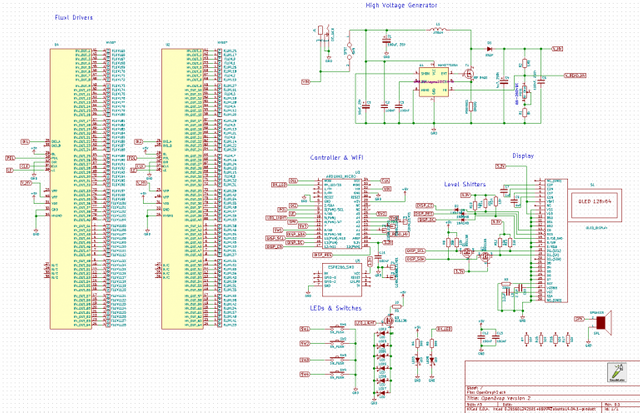
The changing nature of the firm in the 21st century
In the last decades we’ve been observing subsequent and dramatic technological shifts that enabled the emergence of peculiar features in the evolutive nature of firms11.
Deep capillarity of ICT in our daily lives along with networked automation make now possibile to potentially connect everyone with everything. Simultaneoulsy, lower barriers to production means along with componentization of recombinable infrastructural bricks and utility services lead to an increasing shrinking of coordination-transaction costs12.
Moreover, the increasingly easier access of multiple networked users that tend to gather around digitally-enabled platforms of tools and processes to accomplish specific mission-driven purposes is allowing for massive collaborations across geographic boundaries, unleashing an unprecedented convergence of multidisciplinary backgrounds to embrace specific engineering and scientific endeavors faster than traditional firms and research facilities13.
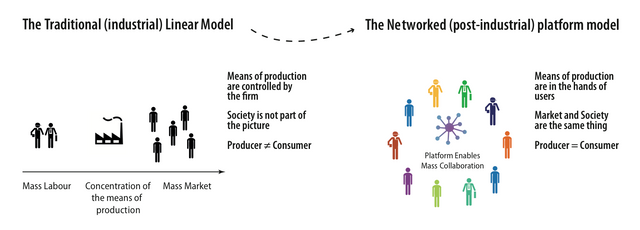
The transition towards a networked model of business has been driven by the collision of several micro-trends and – more in general – from the collision of two mega set of trends: technology on one hand, social and behavioral driven trends on the other14.
More in details, from the technology standpoint we can identify at least the following macro set of trends:
- Pervasive computing and pervasive internet access;
- Modular, open and cheap hardware and the evolution of manufacturing supply chains;
- Widespread dominance of Free and Open Source Software;
- Proliferation of data and falling cost of data storage;
- Growth of alternative capital access means (e.g. crowdfunding, cryptoassets issuance) and Co-Creation to validate ultra niche products.
Whereas from a social and user driven perspectives, the key drivers can be at least partially identified as follows:
- Rise of collaborative, shared and efficient use of resources;
- Growth of asset light lifestyles and the need for cheap price access to services;
- Rise of environmental and social awareness and of the search for sustainable products and services;
- Growing importance of experiences over products as a result of omni-channel access;
- Connectedness enabling access trump ownership.
Non-traditional organisations, as for instance networked research institutes, can now play a decisive “platform” role in organizing and designing an architecture of exchanges, incentives and experiences that - by leveraging on the collaboration of peers and partners (generally small, agile, professionalized players) can strongly redesign or invent markets, competing and disrutping traditional firms and traditional research models15.
We define as Digital Platform16 a series of tools and codified processes of interaction that enable a series of (one or many) sub-actions, strongly related, during which value –in any form– is either created, provided, transferred or traded among two (most often) or more entities that interact within the platform.
It is important to remark that the wider meaning of the term “platform” doesn’t refer uniquely to a software platform, which in fact is needed albeit not sufficient. A digitally-mediated platform is first of all an organisational model17 to rethink, reconnect and develop the whole set of processes within an organisation.
More specifically, a platform is made of:
- A governance structure, including a set of protocols that determines who can participate, what roles they might play, how they might interact, how decisions are collectively made, and how disputes get resolved;
- An additional set of protocols or standards that are typically designed to facilitate connection, coordination, and collaboration between contributors.
Usually, digitally-mediated platforms provide empowerment and enabling services that are targeted to helping producing entities (peer contribuors and partners) improving their capabilities.
Examples of empowering and enabling services can vary from: APIs, SDKs, organizing an event or gather the whole ecosystem18 (e.g.: a developer conference; an hackathon, a professionalising workshop etc.).
In the field of Open Science19 and more in general, in any networked collaborative engineering endevaour is extremely important to shape the features of the platform into what we can call a Learning Platform20: that facilitate learning, bring participants together to share insights, foster deep/trust based relationships, help participants realize more together.
The case of OpenDrop DCO
OD emerged as independent project from spontaneous and asyncronous collaborations of individuals whitin a series of already existing open science networks, such as Hackteria.org, Gaudi.ch, Bioflux.eu and Waag Society, with the remarkable support of the Synenrgene.eu consortium within EU’s 7P framework.
OD is now designing and implementing a commons-based infrastructure to enable both for-profit and not-for-profit endeavours to co-exists within the same ecosystem. More in details, OD operational architecture is based on the principles of commons-based peer production (value-driven and reputation-tied), collaborative decision making, real-time strategy, long-term envisioning methodologies, and a participatory open governance model.
This non-canonical framework – as opposed to ortodox STEM research paradigms – aims at leveraging the power of crowdsourced science, open innovation, and lean management to develop with other partners an ecosystem where digital biology can flourish.
“You may have the greatest bunch of individual stars in the world, but if they don't play together, the club won't be worth a dime.”
–– Babe Ruth
Our governance and operational model is derived from the LiquidOTM whitepaper (v 1.5)8, released in 2014 by the consulting boutique Cocoon Projects, which is licensed under Creative Commons Licence NC-SA. The LiquidOTM model define a thorough methodology to design a new breed of organisational models, responding to the fast growing adaptability, engagement and collaboration needs within modern company structures. This model resolve the sound problems of slowness, rigidity, bureaucracy, disengagement along with various kinds of waste and bottlenecks that “traditional” organisational models generate and suffer nowadays.
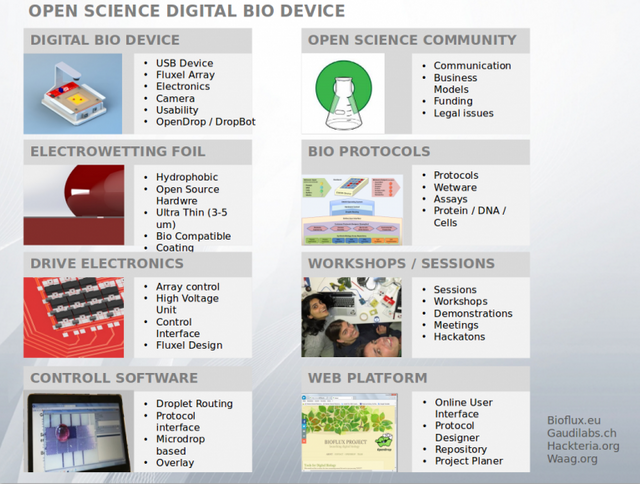
OD is the first attempt to deploy this breed of organisational model inside STEM research. Within OD all members are equal, nobody is the boss of anybody else, there are no job titles: just people with their competences, which in a Learning Platform can grow at a very fast pace. The OD community stands at the center of the collaborative development and maintainance of the OD ecosystem bounded to the rules of the governance model.
The model we adopt includes some rhythmic rituals to keep all participants in the community aligned within the governance of the whole organisation. These are timeboxed, inclusive, live and/or online meetings that happen regularly, and which usually anybody (within the governance) can join freely.
Excerpts from the LiquidOTM white paper from which our governance model is derived:
It is very important to foresee and define these alignment events since there is nobody with a functional responsibility of watching out for specific problems and opportunities, therefore requiring the right context for having them emerge from the people and being inserted in the governance platform.
Everybody can decide in real time which activities and decisions to take part to, choosing the challenges and problems where to be potentially most useful. Credit will be awarded by peers after results are reached, and reputation will be built upon the dynamics that every member chooses and expresses for herself.
Moreover, being based on Lean Management and Open Collaboration principles, the LiquidOTM model assumes that waste elimination can be radically embraced, removing everything that is not contributing to the creation of value towards the company’s goals, that of course includes the company’s health itself. Job interviews, for example, are not a meaningful way of using time.
The most efficient (and effective) way to verify anybody’s fit within an organisation, is letting them immediately in and let them work just like all the regular members but in a “safe zone”, and see if they fit-in. We call this zone Contributorship.
WITH CREDIT COMES COMPENSATION AND DECISIONAL POWER, AND THE LOOP IS CONTINUOUSLY RENEWED.
The stakeholders of the OD community are:
- Partners (individuals, firms and research institutions that are consistently involved in the value-creation through shared platform components provided by platform developers. Partners are the designer and creator of the core-assets that drives our multi-sided business model, and that are tied to the cryptoassets: bio-protocols, new hardware components, and other up stacked business models);
- Investors (they believe in the vision and mission of OD and they participate with capital in exchange of equity in the form of a tradable crypto-asset. They lack of decision power within the governance [if they are not also Members or Contributors] but they can liquidate their position at any time);
- Members (those entities that have created the platform and that are ultimately responsible for platform maintainance, development and success. They participate in governance and operational activities just as Contributors, but they have final decision power on prioritization and other critical decisions);
- Contributors (representing the driving core of the value creation, participating in governance and daily operations. They have execution power on daily activities, means that they can propose new activities and lead them if such activities are alligned to the strategy decided in the previous strategic meeting. They have voting power only in the context of the periodic strategic meetings);
- Users (mainly end customers, whose interactions and behaviours within the OD platform context drive the value creation by providing meaningful insights for OD development).
Governance is divided into decisional and executional power, blendly distributed among the two categories of active participants: Contributors and Members.
On a daily base decisional level, the former can propose new activities relevant for the current six-monthly mission. Contributors can also take part to mission definition with voting power by participating to periodic timeboxed rituals that are (usually) live strategy meetings. Whereas members have equal decision power among them in accepting and prioritzing proposals of activities that could come from both members and/or contributors, and moreover they can officially represent OD in external institutional meetings.
For what concerns the executional level, both members and contributors can equally take part to activities deciding in real time the challenges and problems where to be potentially most useful.
Credits will be awarded by contributors after results are reached, and reputation will be built upon the contribution dynamics that every member chooses for herself. With credits comes compensation and decisional power, and the loop is continuosly renewed. Within OD nobody is the boss of anybody else, there are no job titles: just people with their competences, which in a Learning Platform can grow at a very fast pace.
Each governance activity has a value in credits, estimated by all the participants to that activity and averaged by the system. These estimates can be changed in any moment, real-time following actual work, until the activity is completed.
After the activity’s been completed and accepted, its weight in credits is distributed to all the participants to that activity. This happens by a retrospective shares evaluation executed by each participant of how much value (and not time or effort) each person has brought into the final result. The system averages the shares evaluation for each participant and distributes the activity credits in that proportion to the participants. The credits earned with this mechanism are directly converted into money compensation.
-- From LiquidOTMwhitepaper from which OD Governance is inspired.
OD operational structure is divided into two main branches: Business Development and Research & Development. Both branches are composed by stream of activities which as for the open governance framework are open to anyone who decide to contribute. Business Development tasks are concerned of integrating the strategy, carrying out the ongoing customer discovery which takes and provide with insights to the R&D branch. Legals, funding, and communication matters are also part of Business Development duties. R&D branch’s tasks are mainly focused on hardware, software, wetware develpment and other minor collateral activities.
Open Drop Research & Development blueprint
Currently, OD six-monthly mission is focused on releasing the v.3 of the OD prototyping board which features the support for the modular cartridge and a series of addtional components. Moreover, dev efforts are mainly conveyed to the systematic translastion of human redable standard protocols that has been selected among the fifty most labor-intensive protocols oftenly used in molecular biology laboratories.
Each protocol is manually componentized according to the rationale that – given hardware constraints – any bio-protocol consists of:
- objects (samples, probes, reagents, solvents, buffers, salts, etc.);
- moves (dispense, merge, mix, split, incubate , detect etc.) that can be clustered into cycles;
- timings (each move is –to a certain degree– time-dependent).
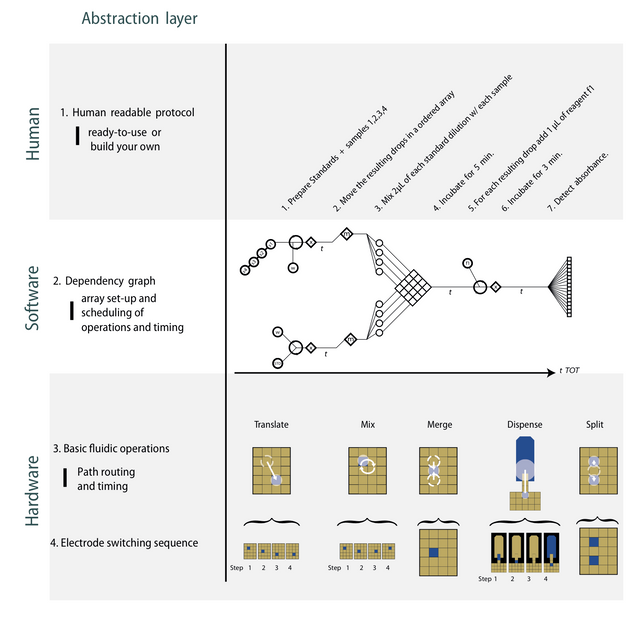
The core blueprint for hardware and software development consists of a series of hierarchical abstraction layers. In pursuit of a user-centric perspective, the first abstraction layer is the UX interface whose selectors have been previously defined by a machine learning algortithm that intuitively suggests the most common path that users would follow.
Whether a protocol has been selected or created from scratch by the user by combining its components and setting variables at high level interface, the software would calculate and verify the logic dependency graph that inform how the user should set-up the array for the dispensing and retrival of drops.
From the aforementioned dependency graph, the software can derive the scheduling of operation sequences and timing that define the protocol, which is therefore translated into the set of possible basic fluidic operations, (dispense, move, merge, mix, translate, split) from which ultimately is derived the path routing and timing of the electrode switching sequences. After a digital biology protocol has been executed and validated by the user who has created it, it can be saved and/or shared among other users in the network, and thus be further validated and developed by the network.
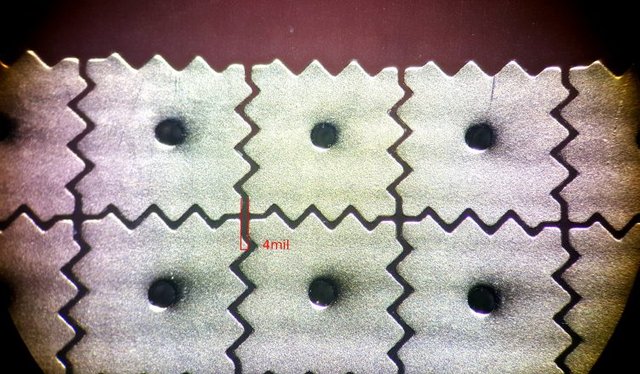
We are planning to release the hardware by levearing traditional crowdfunidng on a major crowdfunding platform in Q4 2016/Q1 2017.
Current Roadmap
- August-September 2016: 1st crowdsale of FLUXEL coins that represents equity, it will be announced here on Steemit and other major cryptoworld communication channels. This first wave will grant equity at the maximum rate. Furhter details soon.
- December 2016-January 2017: Kickstarter campaign to sell the hardware.
- February-March 2017: 2nd and last crowdsale of FLUXEL coins for three weeks with three down-scaling rate tiers.
- End of May-June 2017 FLUXEL coins distribution and shipping of the hardware
How you can support us?
First by upvoting this post with no effort! You can stay tuned here on Steemit for further information for the FLUXEL ICO and hardware development.
We will also announce it on other common channels, but we prefer to start from here. : ^ )
Contacts:
For governance, ICO, and crypto-related questions you can contact me via email here.
For questions about the hardware, bio-protocols, micro and nano technology visit GaudiLabs website and contact Urs Gaudenz
To know more about the ecosystem:
- Please visit the OpenDrop Website to be updated on hardware development. Stay tuned here for further information on the crowdequity presale.
- http://hackteria.org/wiki/Elektrowetting
- http://www.bioflux.eu
- http://digi.bio/
- http://microfluidics.utoronto.ca/dropbot/
- Luis Ruben Soenksen, a PhD student at Massachusetts Institute of Technology (MIT) is developing a wild OpenDrop V2.1. Luis is working on innovation & Entrepreneurship activities at the Research Laboratory of Electronics & MIT in affiliation with the Madrid-MIT M+Visión Biomedical Imaging Consortium. He is planing to use a new smart responsive surfaces switching coating on the OpenDrop and do some very interesting biology such as multi-organ on chip interaction experiments (in collaboration with the Griffith and Trumper labs).
Acknowledgments
OpenDrop was selected for poster presentation at the 2015 NanoBioTech Montreux conference, a unique high level conference at the frontiers of Micro- and NanoTechnology developments for Biological, Chemical and Medical applications that happens every year since 1997, and that is organised by an association of leading scientists of EPFL, ETH and other high level research institutions. We therefore want to thanks Prof. Philippe Renaud @ EPFL for understanding our disruptive vision and having invited us at this amazing conference for free.
We want to express our deepest appreaciation to Andy Gracie, Marc Dusseiller and Yashas Shetty for having sparked the Hackteria network in 2009, to which the galactic diy-bio community is greatful for being such a remarkable relational context and source of meaningful insights (and trustful vulcanian contacts).
We also want to thank Ryan and Christian Fobel from Wheeler Microfluidics Laboratory and their open source DropBot 2.0 and µDrop software from which OpenDrop development has been greatly inspired. Also, we would like to thank Mirela Alistar and Rüdiger Trojok for having sketched-up the first prototype of OpenDrop on a napkin in a cafè in Vienna (AT) in October 2014. Ultimately, we are thankful to Simone Cicero and Stelio Verzera for being some of the first pioneers to have seriously experimented within the mindshifting paradigm of networked organisations. Last but not the least, we want to thank Satoshi Nakamoto for its seminal paper on DLTs.
References
Oh this is absolutely awesome!
I'm getting in line for one of these, will definitely have a spot on my Bio bench.
@piedpiper, we need this at Fort Galt for sure!
He already agreed to reserve one for us ;)
Guys, I hope to come back to Chile the next year, as well as you are more than welcome to visit the sinking Europe! : ^ ) I had great time with @piedpiper in Chile.
I can't wait until the big crowd sale!
i will watching for this project, waiting for more information about your project
This is very important for the chemical industry?
Hi @leonaugus, it's more important for the biomedical industry which is the main target. Albeit its success could impact certain silos of chemical and microelectronic industries as well, as it relies on their supply chains.
Aw yiss. I do like myself a highly specific appcoin token. I'll be following this closely. (And rereading the post so I understand the whole point of the tech.)
who also thinks that steemit will be just as big as bitcoin or bigger ?